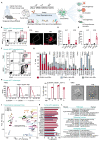Restoring tumor immunogenicity with dendritic cell reprogramming
- PMID: 37418548
- PMCID: PMC7614848
- DOI: 10.1126/sciimmunol.add4817
Restoring tumor immunogenicity with dendritic cell reprogramming
Abstract
Decreased antigen presentation contributes to the ability of cancer cells to evade the immune system. We used the minimal gene regulatory network of type 1 conventional dendritic cells (cDC1) to reprogram cancer cells into professional antigen-presenting cells (tumor-APCs). Enforced expression of the transcription factors PU.1, IRF8, and BATF3 (PIB) was sufficient to induce the cDC1 phenotype in 36 cell lines derived from human and mouse hematological and solid tumors. Within 9 days of reprogramming, tumor-APCs acquired transcriptional and epigenetic programs associated with cDC1 cells. Reprogramming restored the expression of antigen presentation complexes and costimulatory molecules on the surfaces of tumor cells, allowing the presentation of endogenous tumor antigens on MHC-I and facilitating targeted killing by CD8+ T cells. Functionally, tumor-APCs engulfed and processed proteins and dead cells, secreted inflammatory cytokines, and cross-presented antigens to naïve CD8+ T cells. Human primary tumor cells could also be reprogrammed to increase their capability to present antigen and to activate patient-specific tumor-infiltrating lymphocytes. In addition to acquiring improved antigen presentation, tumor-APCs had impaired tumorigenicity in vitro and in vivo. Injection of in vitro generated melanoma-derived tumor-APCs into subcutaneous melanoma tumors delayed tumor growth and increased survival in mice. Antitumor immunity elicited by tumor-APCs was synergistic with immune checkpoint inhibitors. Our approach serves as a platform for the development of immunotherapies that endow cancer cells with the capability to process and present endogenous tumor antigens.
Conflict of interest statement
Figures








References
-
- Jhunjhunwala S, Hammer C, Delamarre L. Antigen presentation in cancer: insights into tumour immunogenicity and immune evasion. Nat Rev Cancer. 2021;21:298–312. - PubMed
-
- Hashimoto M, Kamphorst AO, Im SJ, Kissick HT, Pillai RN, Ramalingam SS, Araki K, Ahmed R. CD8 T Cell Exhaustion in Chronic Infection and Cancer: Opportunities for Interventions. Annu Rev Med. 2018;69:301–318. - PubMed
MeSH terms
Substances
Grants and funding
LinkOut - more resources
Full Text Sources
Other Literature Sources
Medical
Molecular Biology Databases
Research Materials
Miscellaneous

